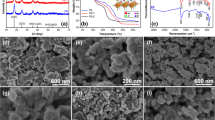Abstract
We have synthesized NiCo2O4 nanoparticles (NCO NPs) using an ascorbic acid-assisted co-precipitation method for the first time. When NCO NPs are used as an anode material for lithium-ion batteries, the cell exhibits superior lithium storage properties, such as high capacity (700 mA h g−1 after 300 cycles at 200 mA g−1), excellent rate capabilities (applied current density range 100–1200 mA g−1), and impressive cycling stability (at 1200 mA g−1 up to 650 cycles). The enhanced electrochemical properties of NCO NPs are due to the nanometer dimensions which not only offers a smooth charge-transport pathway and short diffusion paths of the lithium ions but also adequate spaces for volume expansion during Li storage. Hence, this eco-friendly synthesis approach will provide a new strategy for the synthesis of various nanostructured metal oxide compounds, for energy conversion and storage systems applications.




Similar content being viewed by others
References
X.Y. Zhou, G.H. Chen, J.J. Tang, Y.P. Ren, and J. Yang, J. Power Source 299, 97 (2015).
F. Wu, J. Bai, J. Feng, and S. Xiong, Nanoscale 7, 17211 (2015).
V. Mullaivananathan, K.R. Saravanan, and N. Kalaiselvi, JOM 69, 1497 (2017).
Y. Yan, G. Guo, T. Li, D. Han, J. Zheng, J. Hu, D. Yang, and A. Dong, Electrochim. Acta 246, 43 (2017).
M. Kundu, G. Karunakaran, E. Kolesnikov, V.E. Sergeevna, S. Kumari, M.V. Gorshenkov, and D. Kuznetsov, J. Ind. Eng. Chem. 59, 90 (2018).
M. Islam, G. Ali, M.-G. Jeong, W. Choi, K.Y. Chung, H.-G. Jung, and A.C.S. Appl, Mater. Interfaces 9, 14833 (2017).
Z. Ma, X. Yuan, L. Li, Z.-F. Ma, L. Zhang, L. Mai, and J. Zhang, J. Power Sources 291, 156 (2015).
S. Liu, J. Wu, J. Zhou, G. Fang, and S. Liang, Electrochim. Acta 176, 1 (2015).
J. Xu, D. Su, W. Bao, Y. Zhao, X. Xie, and G. Wang, Carbon 109, 616 (2016).
M. Kundu, S. Mahanty, and R.N. Basu, Mater. Chem. Phys. 130, 20 (2011).
Y. Zhang, Z. Lu, M. Guo, Z. Bai, and B. Tang, JOM 68, 2952 (2016).
Y. Wang, P. Liu, K. Zhu, J. Wang, and J. Liu, Nanoscale 9, 14979 (2017).
L. Li, L. Shen, P. Nie, G. Pang, J. Wang, H. Li, S. Dong, and X. Zhang, J. Mater. Chem. A 3, 24309 (2015).
B. Wang, S. Cai, G. Wang, X. Liu, H. Wang, and J. Bai, J. Colloid Interface Sci. 513, 797 (2018).
X. Zhang, Y. Zhou, B. Luo, H. Zhu, W. Chu, and K. Huang, Nano-Micro Lett. 10, 13 (2018).
J. Xu, D. Su, W. Bao, Y. Zhao, X. Xie, and G. Wang, J. Alloys Compd. 684, 691 (2016).
Z. Xing, Z. Ju, J. Yang, H. Xu, and Y. Qian, Nano Res. 5, 477 (2012).
M. Kundu, G. Karunakaran, E. Kolesnikov, A. Dmitry, M.V. Gorshenkov, and D. Kuznetsov, Micropor. Mesopor. Mater. 247, 9 (2017).
Acknowledgements
The work was carried out with financial support from the Ministry of Education and Science of the Russian Federation in the framework of increase Competitiveness Program of NUST “MISIS” (No. K3-2017-055), implemented by a governmental decree dated 16th of March 2013, N 211. Dr. M. Sasidharan thanks Ministry of New and Renewable Energy (MNRE-No. 31/03/2014-15/PVSE-R&D), Government of India, for partial funding to carry out the research.
Author information
Authors and Affiliations
Corresponding authors
Rights and permissions
About this article
Cite this article
Karunakaran, G., Maduraiveeran, G., Kolesnikov, E. et al. Ascorbic Acid-Assisted Eco-friendly Synthesis of NiCo2O4 Nanoparticles as an Anode Material for High-Performance Lithium-Ion Batteries. JOM 70, 1416–1422 (2018). https://doi.org/10.1007/s11837-018-2888-y
Received:
Accepted:
Published:
Issue Date:
DOI: https://doi.org/10.1007/s11837-018-2888-y




